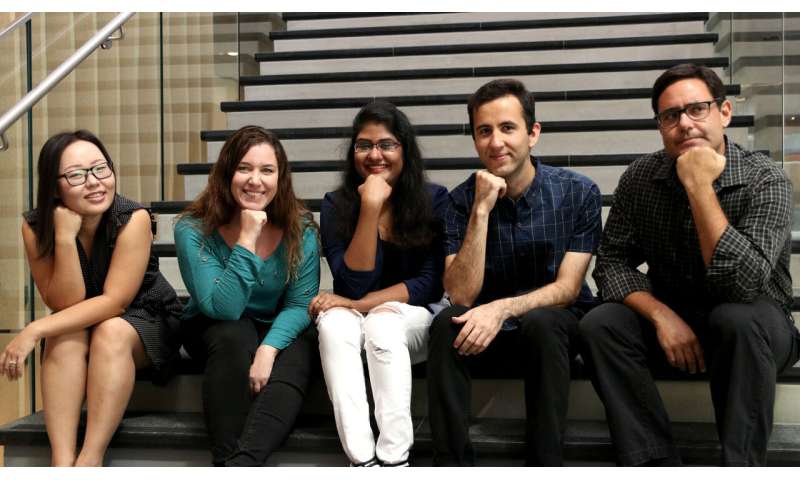
When trying to complete a task we are constantly bombarded by distracting stimuli. How does the brain filter out these distractions and enable us to focus on the task at hand? Psychologists at the University of California, Riverside, have made a discovery that could lead to an answer.
Experimenting on mice, they located the precise spot in the brain where distracting stimuli are blocked. The blocking disables the brain from processing these stimuli, which allows concentration on a particular task to proceed.
Edward Zagha, an assistant professor of psychology, and his team trained mice in a sensory detection task with target and distractor stimuli. The mice learned to respond to rapid stimuli in the target field and ignore identical stimuli in the opposite distractor field. The team used a novel imaging technique, which allows for high spatiotemporal resolution with a cortex-wide field of view, to find where in the brain the distractor stimuli are blocked, resulting in no further signal transmission within the cortex and, therefore, no triggering of a motor response.
“We observed responses to target stimuli in multiple sensory and motor cortical regions,” said Zagha, who led the study published today in the Journal of Neuroscience. “In contrast, responses to distractor stimuli were abruptly suppressed beyond the sensory cortex.”
The cortex is the outer layer of the brain’s cerebrum. Composed of folded gray matter, it plays an important role in consciousness. The largest part of the brain, it has sensory and motor regions. It serves as a control and information-processing center and is responsible for functions such as sensation, perception, memory, attention, language, and advanced motor functions.
“Our discovery may have important implications for the understanding and treatment of neuropsychiatric diseases such as attention deficit hyperactivity disorder and schizophrenia,” Zagha said. “By studying the mechanisms underlying the blocking of distracting stimuli we may be able to unravel the neural circuitry underlying attention and impulse control.”
Zagha explained that while scientists today know much about behavior and neurons, they only have a nascent understanding of how groups of neurons organize to mediate meaningful behaviors.
“A major challenge is recording neuronal activity at high spatiotemporal resolution in animals while they are performing goal-directed tasks,” he said. “A second major challenge is using the correct computational methods to analyze that neuronal activity.”
Zagha stressed they still do not understand what’s happening in the brain that finally allows us to focus on a task at hand and how exactly distractions are blocked.
“But now we know exactly where to look in the brain, and we will be pursuing these questions in the future,” he said. “We know that when someone is highly distractible, their cortex is not sufficiently deploying the intentional signals needed to prevent the distractor stimuli from propagating into working memory or triggering a behavioral response. These processes—’gatekeepers’ of sensory signals—allow through only those signals that are task relevant. We believe this process is orchestrated by the prefrontal cortex; this is only one of the many possibilities we will be testing.”
Zagha’s team presented identical tactile stimuli to opposite sides of mice’s whiskers in random order. The researchers focused on whiskers because they work like human fingertips in terms of sensitivity and exploration; their deflection activates brainstem pathways. The researchers then trained the mice to respond, via licking, to tactile stimuli on only one side and ignore the identical stimuli on the opposite side. Zagha and his colleagues used newly bred transgenic mice that express fluorescent calcium sensors in cortical neurons, allowing the researchers to view brain activity with a camera that helped localize the process with much higher spatial precision than previous studies.
“When distracting stimuli are intentionally being ignored by the mice, we can now see where that distracting stimulus response is blocked,” Zagha said. “In the future, we would want to know how it is blocked.”
Zagha strongly believes the neural circuits underlying sensory selection and impulse control are the same circuits impaired in attention deficit hyperactivity disorder and schizophrenia, leading to the impulse control dysfunctions.
“The better we understand these circuits, the better we can design rational, targeted treatments to improve impulsivity in these disorders,” he said.
The team was surprised by how abruptly the distractor information is blocked in the cortex. The researchers observed that the distractor stimulus responses make it to the first relay in the neocortex, the part of the cerebral cortex concerned with early sensory processing, yet are prevented from spreading further throughout cortex. In future work, the researchers plan to study which specific neural mechanisms prevent the propagation out of this first cortical region.
“The spatial precision of our finding gives us confidence that we know where to look in future studies to reveal how distractor stimuli are blocked, thereby allowing us to retain focus on the task at hand,” Zagha said.
His team will focus also on understanding what the roles are of specific types of neurons and neural pathways involved, how these circuits get disrupted in neuropsychiatric disease, and how the neural system can be modulated to improve distractibility in human disease.
Source: Read Full Article
